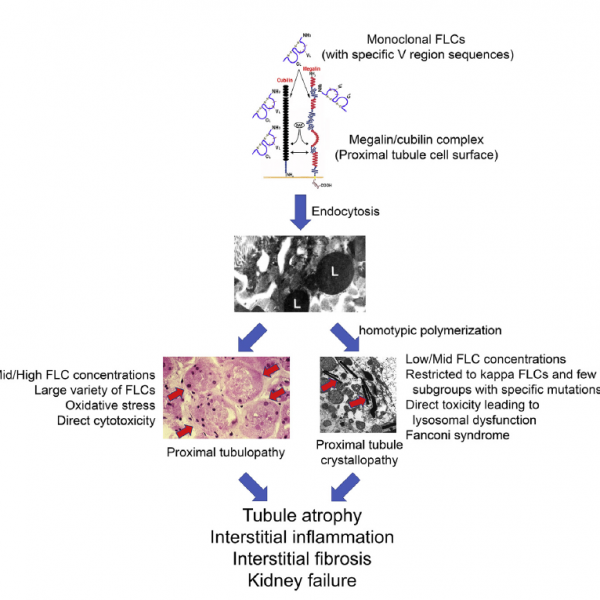
Toxicity of free light chains of monoclonal immunoglobulin: Christophe Sirac provides an update in a review published in KI Reports
Christophe Sirac just published a review in Kidney International Reports. This review focuses on the recent insights gained into the patterns and the mechanisms of proximal tubule toxicity of free light chains, including subtle transport disorders, such as proximal tubule acidosis, partial or complete Fanconi syndrome, or severe acute or chronic renal failure.
Monoclonal immunoglobulin free light chains frequently affect the kidney in a variety of ways, possibly involving both glomeruli and tubules.
Histologically, there may be crystal deposition in the proximal tubule cells. It has been shown that specific structural alterations in the V domain of these free light chains are responsible for the formation of these crystals. Besides crystal formation, excess free light chains can also lead to tubulointerstitial inflammation and proximal tubulopathy, in response to cellular stress caused by excessive endocytosis of these light chains.
Therapy directed against the clonal source of the toxic light chain can prevent progression to more severe lesions and may help preserve kidney function.
This review is the result of the collaboration between :
– CRIBL Unité Mixte de Recherche (UMR) 7276/Institut National de la Santé et de la Recherche Médicale (INSERM) U1262, Centre National de la Recherche Scientifique (CNRS), Université de Limoges, Limoges, France.
– Centre National de l’Amylose AL et Autres Maladies par Dépôts d’Immunoglobulines Monoclonales, Centre Hospitalier Universitaire de Limoges, Limoges, France.
– John W. Deming Department of Medicine, Tulane University School of Medicine, New Orleans, Louisiana, USA.
– Department of Veterans Affairs, Southeast Louisiana Veterans Health Care System, New Orleans, Louisiana, USA.
– Division of Nephrology, Department of Medicine, University of Alabama at Birmingham, Birmingham, Alabama, USA.
Department of Veterans Affairs, Birmingham Veterans Affairs Health Care System, Birmingham, Alabama, USA.
Text link : https://doi.org/10.1016/j.ekir.2021.02.026

